Today, our editorial team has prepared a review of the Arturia V Collection 11, a bundle of virtual instruments and we'll tell you in detail about the six new products that complete it. The French manufacturer Arturia delighted fans with six new products in its 2025 update of the popular V Collection of virtual instruments. The new products include four synthesizers: the Jup-8000 V, Synthx V, Pure LoFi, and MiniBrute V; as well as two hybrid instruments from the Augmented MALLETS and YANGTZE series. Additionally, the SEM V synthesizer and Augmented series instruments have been redesigned.
Starting this year, a simplified version of the V Collection Intro will be available with a limited set of instruments at an affordable price. It includes only one-fourth of Arturia's total instruments but provides an overview of the collection's capabilities.
The current V Collection 11 version includes 45 complete products with original sounds, detailed customization, and unique control features. Each virtual instrument can be used as a VST, AU, or AAX plug-in, or as an independent standalone application. The full version of V Collection 11 PRO costs $699. The introductory version, V Collection 11 INTRO, will cost $199.
As you know, the V Collection consists of software versions of iconic keyboard instruments from last century. The new Jup-8000 V and Synthx V synthesizers continue this tradition by emulating hardware synthesizers from years past. Among the new products are our original creations. For instance, the MiniBrute V synthesizer recreates the sound of Arturia's modern analog synthesizer of the same name. The Pure LoFi instrument is designed to produce a distinctive lo-fi sound. The remaining two instruments in the Augmented series are creative instruments with powerful morphing tools. As usual, we will focus only on the six new instruments in this series. You can read about the other instruments in the Arturia V Collection 11 in our previous review.
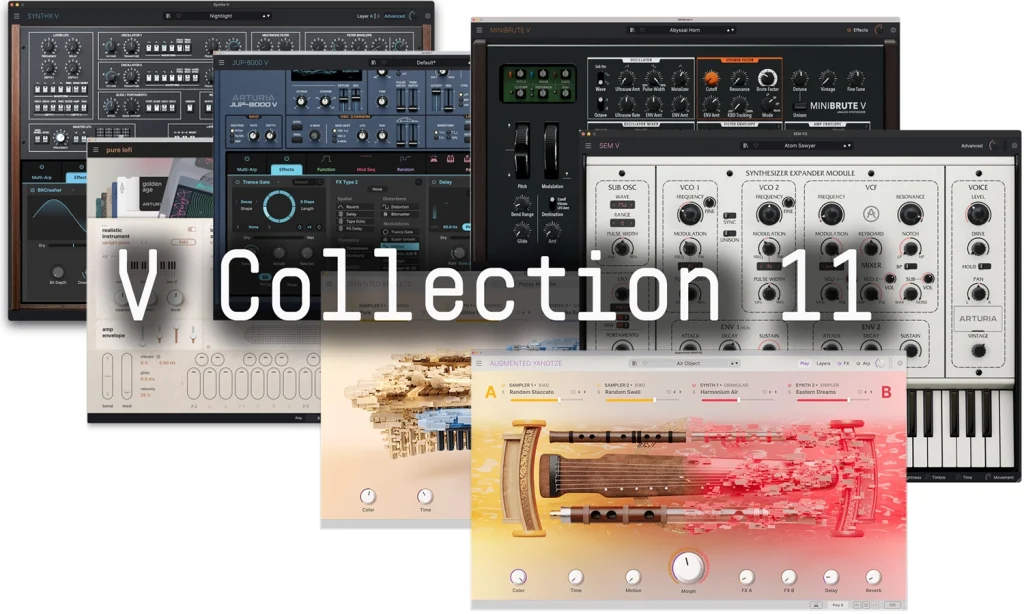
It should be noted that Arturia virtual instruments are fully modeled and use virtually no samples. First, this allows you to achieve a vivid and expressive sound. Second, you have control over diverse and unexpected settings unavailable in sampler solutions. Arturia tries to recreate all the details of original instruments from that time in its products, taking into account the peculiarities of electrical circuits and mechanisms. In addition to faithful emulation, Arturia's software analogues are equipped with modern features. These include presets, automation, additional modulation, modern effects, and much more.

The JP-8000 V is a software version of Roland's iconic JP-8000 digital synthesizer, which was widely used in 2000s electronic music. One of the synthesizer's most distinctive features is its bright oscillator sound, called Supersaw. This sound is based on seven sawtooth waves that are slightly distorted up and down in pitch and do not sound in unison. The JP-8000's characteristic timbre has largely defined the sound of trance music.
Arturia's virtual version of the synthesizer is notable because it emulates the sound of an authentic instrument rather than simply repeating Roland's software algorithms. Additionally, the Jup-8000 V has advanced features that make it easy to use in modern projects.
At the heart of the synthesizer are two oscillators. The first oscillator is the most important and determines the synthesizer's characteristic sound. Seven different wave types can be selected from this oscillator: Supersaw, triangle modulation, noise, feedback oscillator, square, saw, and triangle. A small display clearly shows the selected waveform for convenience. Of the available oscillator adjustments, two fixed controls change the pitch of the main tone and two sliders change the basic parameters depending on the selected waveform. The second optional oscillator can only generate three waveform types: square, triangle, and sawtooth. It has two trim controls and two sliders with fixed waveform settings. A balance control is provided for volume matching between the oscillators. The second oscillator can also modulate the first oscillator. The OSC COMMON section contains the modulation interaction settings.
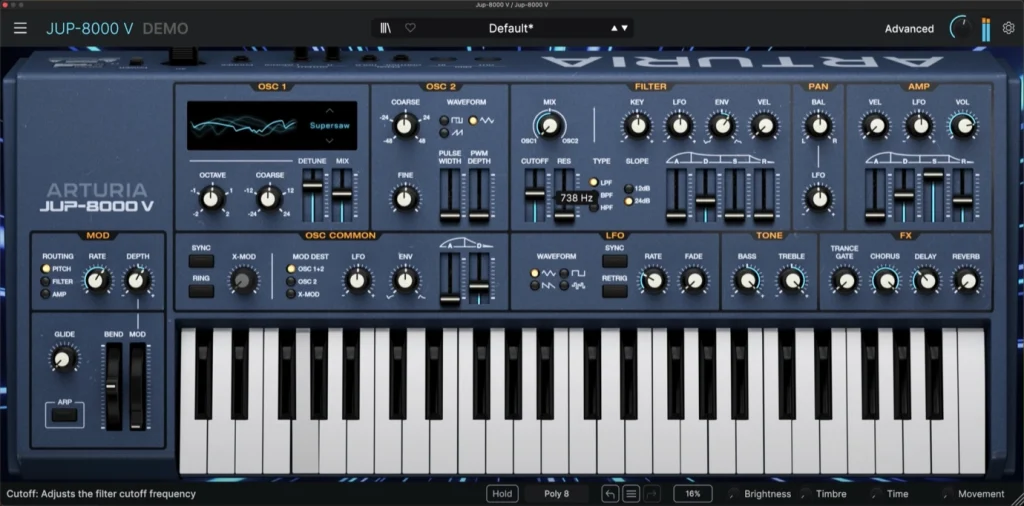
Arturia didn't add anything new to the filter; they simply recreated the sound of a hardware instrument filter. It has three operating modes and simple controls. The envelope and cutoff frequency modulation settings are located in the same section. The amplitude envelope is presented in ADSR form. You can select one of three wave types or Sample & Hold mode as the LFO.
The Jup-8000 V synthesizer allows you to use up to four effects simultaneously. Only the controls that change its intensity are available in the main tab. Detailed parameters are available in the advanced settings, which are extensive for a virtual instrument. These include a sequencer with an arpeggiator, advanced modulation functions, and flexible settings for interaction with a MIDI keyboard, as well as macro assignment.
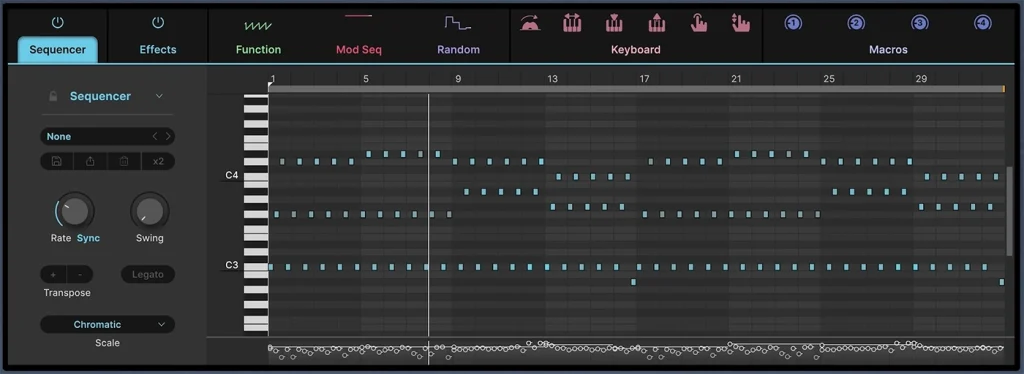
The polyphonic sequencer in the Jup-8000 V has the usual piano roll, which allows for convenient sequence editing similar to a DAW. The maximum sequencing duration is 64 beats. For convenience, there are ready-made rhythmic patterns that can easily be tweaked or modified.

The arpeggiator is interesting as well. It allows you to use up to four arpeggios simultaneously with different patterns and durations. The arpeggiator is graphically designed in a fairly original and convenient way, allowing you to see all the parameters used at once. As in the sequencer, there are various ready-made patterns for the most common synthesizer presets.

The effects section is divided into four categories, and the effects are used sequentially. There are 17 types of effects to choose from, including frequency, dynamic, and spatial signal processing effects. As you can see, each effect has a visualization and additional settings.

Three additional sources provide advanced modulation facilities, allowing you to modulate almost all of the synthesizer's basic parameters. You can choose from five modulation source types. Envelope mode offers an optional ADSR envelope, Function mode lets you create any envelope type, and Random rhythmically changes values. The Voice Modulator creates new values when a new note is played, and the Mod Sequencer animates them rhythmically.
The Arturia Jup-8000 V synthesizer is interesting not only for its excellent graphics but also for its advanced features, including additional modulation and built-in effects. Like other recreated V Collection synthesizers, the sound quality of the synthesizer is top-notch. You can find a demo version and examples of its sound on the manufacturer's official website.
The Synthex Synthesizer is an emulation of the rare and fascinating Elka Synthex synthesizer. This programmable, eight-voice, polyphonic synthesizer was produced in Italy in the 1980s. The Elka Synthex was the first polyphonic synthesizer to successfully produce high-quality sound with digitally controlled oscillators (DCOs). Thanks to the stability of the DCO, the Synthex stood out among competitors like the Prophet, OB, and Jupiter. Today, it is considered one of the best analog polysynths ever created.
A key feature of the synthesizer is its bitimbrality. This means it can produce two complete timbres simultaneously, as if it were two separate synthesizers. Of course, you can use only one tone, but the synthesizer sounds much more interesting in multitimbral mode.
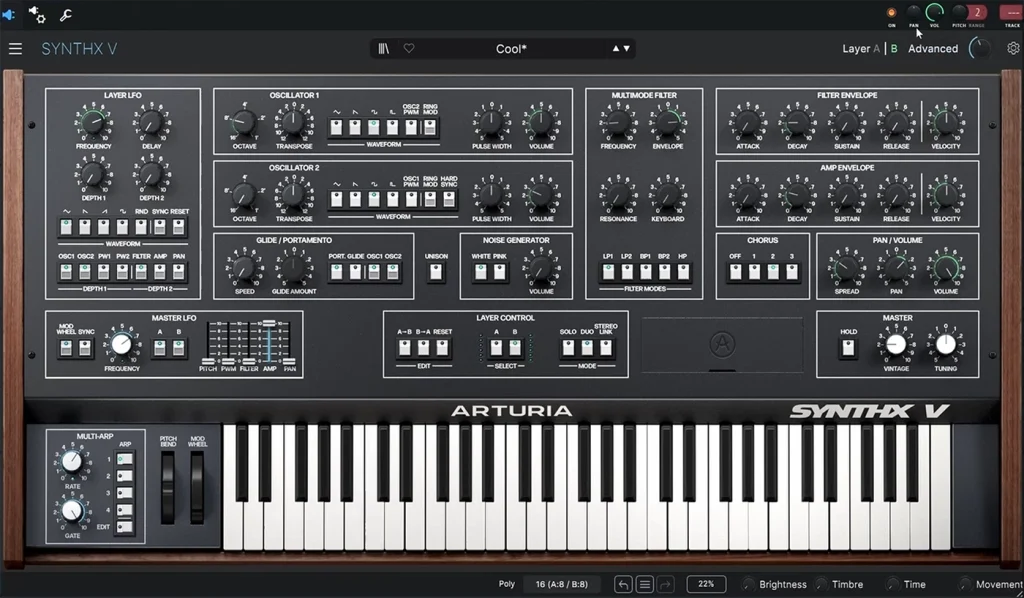
It is based on two identical oscillators with fixed wave types. The available settings include only the pitch of the main tone, pulse width, and volume. The oscillators can also serve as a source of ring modulation for each other. A white or pink noise generator is also provided for creating the main sound. A resonant filter is used as a filter with the ability to operate in five modes. The filter envelopes and amplitudes are presented in the traditional ADSR form.
Since the synthesizer operates the two tones separately, there is a separate low-frequency oscillator (LFO) for each layer. Interestingly, there is a separate depth control for each type of modulation. The LFO wizard allows you to use the LFO for two layers at once. However, the waveform cannot be changed — it is a triangle.
Although the virtual synthesizer uses many modern effects, the hardware chorus effect was chosen for emulation. As with the original instrument, there are three chorus modes, which allow you to gradually saturate the sound.
Synthex V's UNISON mode is also interesting because it folds all voices of the selected layer into one to create a rich sound. The sound becomes monophonic and single-voice, but very dense and collected. This is especially suitable for bass timbres and leads. The fact that the sound becomes monophonic shouldn't be a concern because there is a SPREAD control in the PAN/VOLUME section. It extends all the voices of the unison across the panorama, turning the mono timbre into a stereo sound.

Arturia has equipped the synthesizer with an additional oscillator dispersion section that affects both layers simultaneously to add warmth and analog character to the synthesizer's sound. If the Synthex V sound seems overly refined, you can add divergence and variation.
Advanced settings provide access to additional features, similar to those of the previous Jup-8000 V product.

Here, you can access an arpeggiator/sequencer, an effects block, three additional modulation sources, controller interaction settings, and macro assignments.
You can evaluate the Synthex V sound and usability yourself using the examples and demo version on the official product page. The synthesizer is another standout in the V Collection library, fully embodying the manufacturer's vision. Arturia's Elka Synthex analog sound emulation is thorough.
The MiniBrute V software synthesizer is an electronic version of Arturia's first analog synthesizer, the MiniBrute. Following the addition of the MiniFreak V synthesizer to the Arturia collection, the creation of a MiniBrute V software synthesizer was inevitable. Now, in V Collection 11, we have a second virtual synthesizer that fully replicates the iron instrument of the same name. It's important to note that the MiniBrute V emulates the original MiniBrute synthesizer from 2012 and not the current MiniBrute 2.
The MiniBrute V synthesizer has all the features of the MiniBrute hardware synthesizer and several advantages. First and foremost, the MiniBrute V is polyphonic. It can play in four- or eight-voice mode, as well as retrigger and mono legato modes. Additionally, the synthesizer has an extra four-effects section.

It uses a single oscillator that generates multiple waveforms simultaneously, and the effect of each waveform is continuously adjustable. For clarity and ease of operation, adjustments are made with separate faders, as in traditional mixers. The oscillator settings allow for individual variation options for each waveform. For a sawtooth waveform, the Ultrasaw Amount duplicates the phase-shifted waveform. For a meander waveform, the pulse width is adjustable. And for a triangle waveform, the Metalizer adjusts the saturation of the spectrum with harmonics.
As a filter, the familiar Steiner-Parker two-pole filter is used. The Brute Factor function is the signature feature of all Arturia synthesizers in the Brute family. It saturates the signal spectrum in a way reminiscent of an amplifier's self-excitation. The software version of the synthesizer perfectly models this function, allowing you to add characteristic saturation to your sound.
A single oscillator with a choice of noise or one of five waveforms is used as the LFO. In addition to adjusting the height and frequency of the oscillation, you can adjust the amplitude, filter cutoff frequency, and pulse width.
One of the most interesting features is the Unison mode, which combines all voices into one and turns the synthesizer into a monophonic instrument. There is also an additional section with some scattered oscillator parameters, which allow you to give the sound analog instability.
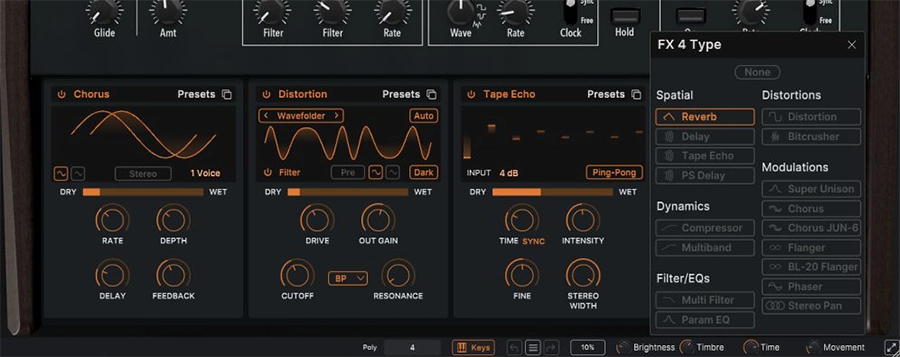
The synthesizer presents effects as a chain of four stereo effects that work in sequence. Each of the four slots offers a choice of seventeen guitar pedal-style effects. Frequency, dynamic, and spatial signal processing algorithms are provided. These standard effects are used in many Arturia products.
The MiniBrute V will appeal to fans of classic sounds, offering limited synthesis capabilities and simple controls. At the same time, its timbre is quite interesting and fresh. Examples of sounds can be found on the official MiniBrute page.
On our site, you can also find reviews of the Arturia MiniBrute 2 analog synthesizer and the MiniBrute 2S (which has pads instead of keys).
The Pure LoFi instrument is used to create characteristic Lo-Fi sounds. For the manufacturer, developing such an instrument is a new endeavor, but the Augment series shows that Arturia succeeds not only in recreating hardware synthesizers but also in creating interesting products from scratch.
At the heart of Pure LoFi are three independent sources that form the foundation of the tone. Two of these sources are identical, and you can select a sampler with ready-made samples of various live instruments, including keyboards. You can also use the sampler's creative mode, which offers unique playback options. Or you can choose the LoFi oscillator, which generates a variety of generic waveforms. The third source is a sampler with fragments of noise and short drum and percussion samples. The various timbres of this instrument, ranging from soft pads to complex hybrid textures, are formed by combining different samples in various modes.

The most interesting aspect of Pure LoFi, however, lies in the post-processing. Emulation of hardware devices is available for the instrument's main engines and noticeably colors the sound, giving it a vintage feel. These devices include the Fairlight CMI, Emulator II, Casio SK-1, E-MU SP-1200, Akai S900, and Akai MPC60. There are also three additional Arturia modes that apply beat-crushing and downsampling effects: Deteriorate, Damage, and Crush.

Another interesting feature of Pure LoFi is its LoFi filter. It is based on the LoFi filter of Arturia's flagship synthesizer, Pigments 6. It's a downsampling filter that allows you to add specific coloration. However, the traditional resonant filter is also present.

The main highlight of the instrument is the LoFi processor. With it, you can give your sound the distinctive qualities of reel-to-reel tape recorders and vintage tube amplifiers. The instrument has six coloration modes with different processing algorithms. The Golden Age mode adds warmth, subtle saturation, and soft compression. Velvet Frost gives the sound a light tape character and grit on the highs. Vintage Glow saturates the timbre with a slight analog overdrive. Dim Memories makes the sound fuzzier with a low-end and smoothed transients. Cathodic Tube emulates the bright, harsh sound of tube operation. The Fuzzy Line has a more aggressive, dirty finish.
For ease of operation, there is only one control that adjusts the intensity of the effect. However, additional controls allow for more precise adjustment of the LoFi processing effect on the signal.

In addition to its basic functions, the instrument has advanced features, including an effects block, modulation options, a MIDI controller setup, and macro assignment. This standard extension is used in all of Arturia's recent products.
Pure LoFi is an original and colorful instrument. Those working in the LoFi genre will certainly appreciate it, as it provides a wide range of possibilities for creating the atmospheric sounds characteristic of this musical style.
Sound examples and a full demo version of Pure LoFi are available on the manufacturer's official website.
The following two instruments are part of the Augmented series. They allow you to transform the sound of classical musical instruments. They combine the functions of a sampler and a synthesizer, enabling smooth tone changes. Their powerful morphing capabilities distinguish them from traditional synthesizers and samplers. Augmented uses samples of real instruments. Augmented Mallets includes samples of the celeste, orchestral bells, marimba, and vibraphone. Augmented YANGTZE uses the sounds of Chinese folk instruments.
All instruments in the Augmented series work on the same principle. Each has two main layers, Layer A and Layer B, which transition smoothly. In this case, morphing is a simple crossfade accomplished by changing the volume. However, thanks to a wide range of options for controlling various parameters using macros, more interesting tone changes can be achieved.
A recent update to the Augmented series has changed the interface. These changes were made to optimize user interaction with the instruments, making them easier and more efficient to use. Otherwise, the instruments remain the same.
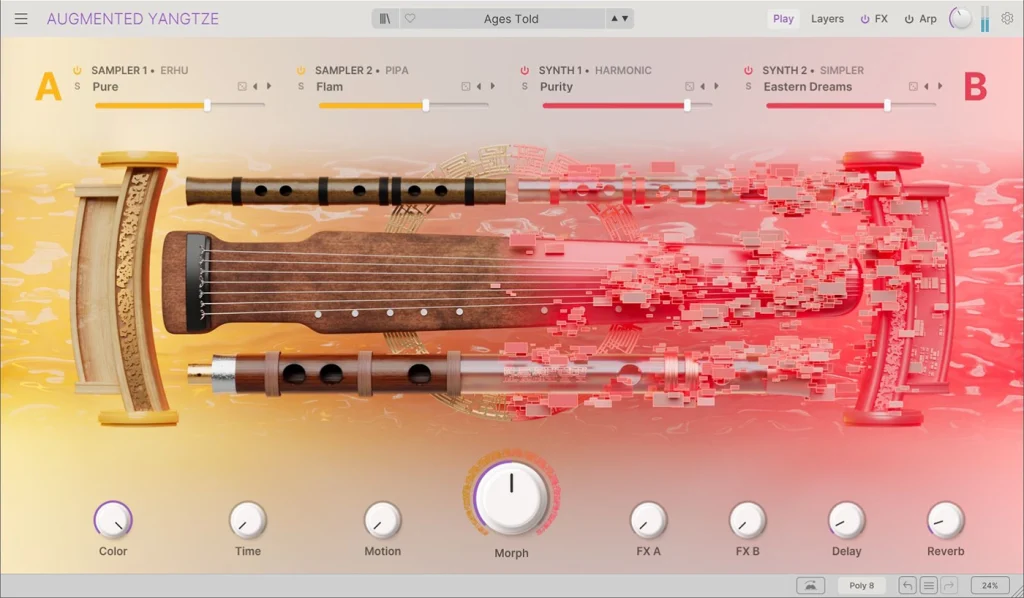
Previously, the main interface only contained controls. Now, however, you can view the samples involved in the current preset directly, as well as switch between them within the selected category. The regulators have been moved to the lower part of the window. Their functionality remains the same.
The four controls on the right represent effect buses. Reverb and Delay act as master effects and cannot be replaced. The other two buses, FX A and FX B, each allow you to select one of 14 effects. The three controls on the left, Colour, Time and Motion, function as macros, enabling you to assign parameters from six different categories. The largest slider, Morph, provides advanced capabilities, enabling you to assign up to twelve parameters simultaneously.

The instrument has two slots for each layer into which you can load a sample of a live instrument or a simple synthesized sound. Although the instrument settings are fairly simple, they allow you to adjust the timbre of the sound slightly. ADSR envelope settings are available for the sampler. When using the synthesizer, you can select one of four synthesis methods: analogue, granular, harmonic or table-wave. Depending on the synthesis method selected, the settings will vary, but the number of settings remains minimal. The signal can then be subjected to filter processing. There are six filter options available in Augmented. The first three — SEM, Multimode and Surgeon — are resonant low-pass filters. The other two — Comb and Phaser — are comb filters. The last option, Formant, is a formant filter.
Changes to the Advanced Mode interface mean that more functions can be used simultaneously. The lower section now displays its parameters separately from the upper section. This gives each section functional autonomy, making them easier to control.

You can use two effects of your choice for each layer. These effects are typical of most Arturia instruments and include filters, a compressor, distortion, a bitcrusher, a chorus, panorama expansion, a phaser, a flanger, reverb, and delay. These effects are customizable and graphically designed, and can be dynamically controlled by different modulation sources.
Multiple modulation sources are provided to control a wide variety of instrument parameters. There are two independent LFO oscillators, two randomizers for random selection, and two additional function oscillators that allow you to select and modify a specific waveform. Additionally, velocity parameters, aftertouch, and pitch and modulation wheels can be used as control sources.
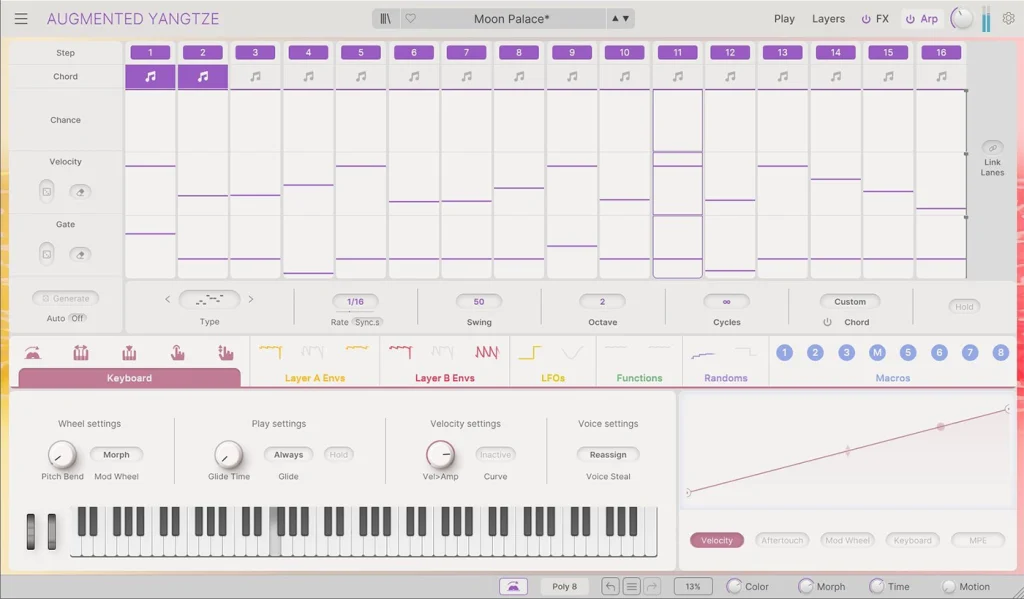
The arpeggiator/sequencer mode remains unchanged. You can still record individual notes and play back entire chords. You can adjust the volume and duration of each note individually.
As we have written before, the Augmented series of instruments is an excellent tool for sound design work. Two new instruments have been added to the series, bringing exotic colours and bright percussion timbres. The plug-ins offer a wide range of presets that unlock the instruments' full potential. We recommend downloading the demo version to try them out. You can find sound examples on the manufacturer's official website.
Finally, we've reached the end of our Arturia V Collection 11 review, and it's time to summarize the results. Arturia continues to build on its success with updates to the popular V Collection of virtual instruments. The latest additions will appeal to fans of both software replicas of analogue synthesizers and modern original solutions. These new products deserve close attention and will make a valuable addition to any musician's collection. Arturia is constantly improving its products by adding new features and capabilities. This enables musicians to keep up with the latest trends and experiment with sound.
Of particular note are the Jup-8000 V and Pure LoFi, both of which are excellent. It is also worth mentioning that the new products now feature a unified interface, which greatly facilitates control and makes working with the instruments more comfortable.
Arturia's V Collection remains one of the most popular among musicians thanks to its quality, variety, and constant development.
We hope you enjoyed our review of the Arturia V Collection 11. Please feel free to leave your comments, questions, and suggestions in the section below. We will be happy to answer them all as soon as possible. If you already own Arturia V Collection 11 Pro or Intro and have used it for a while, don't forget to share your impressions and tell us what you liked or disliked about these virtual instruments. Please also share your thoughts on the 2025 update and the six new instruments.